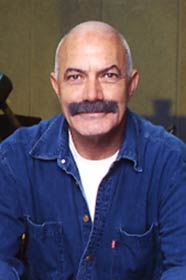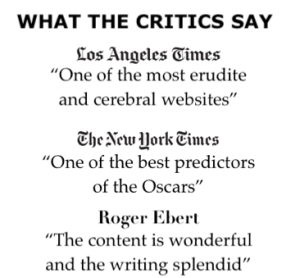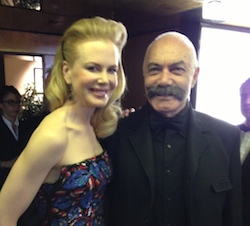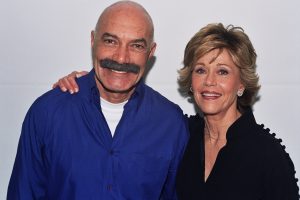Helmed by MGM chief art director Cedric Gibbons (and others), Tarzan and His Mate was the second in the Tarzan film series, made with a more fantastic and opulent look than its predecessor.
The pre-Code action-adventure film was based on the Tarzan character created by Edgar Rice Burroughs, and again starred Johnny Weissmuller and Maureen O’Sullivan.
In 2003, the U.S. Library of Congress deemed the film “culturally, historically or aesthetically significant” and selected it for preservation in the National Film Registry.
Tarzan and Jane live in the jungle, along with Cheeta. Harry Holt and his business partner Martin Arlington, leading a large party of locals, meet them on their way to take ivory from elephant burial ground.
Holt had sought Tarzan out–he was the only one who knew the way to the burial ground. On this trip, Holt tries to convince Jane to return to civilization by bringing her clothing and modern gadgets. Jane tells him she would rather stay with Tarzan, and convinces Tarzan to act as their guide.
Arlington thinks they can use elephants as pack animals, enabling them to haul more ivory. Tarzan, thinking that taking the ivory is profaning the burial ground, refuses.
Arlington and Holt are frantic to continue on. Arlington shoots an elephant, wounding it so that it will lead them to the burial ground. Jane’s intervention keeps Tarzan from murdering Arlington.
After being abandoned by Tarzan and Jane, Arlington and Holt lead their baggage carriers, led by Saidi, following the wounded elephant. Elephants, aware of the impending disgrace of their sacred ground, turn up in the hundreds, and threaten to exterminate Holt and Arlington. Tarzan and Jane arrive in time to save them, after which Arlington feigns repentance, promising to leave without the ivory. Satisfied, Tarzan agrees to guide their departure, and sends the elephants away.
However, Arlington ambushes Tarzan, shooting him out of a tree into the water. After Arlington leaves, hippopotamus rescues semi-conscious Tarzan and carries him to the chimpanzees. Tarzan has received a head wound, but the bullet only grazed him. The head chimpanzee applies plant sap to staunch the bleeding.
Arlington returns, claiming he saw Tarzan being killed by an alligator, and the distraught Jane agrees to return to civilization. Arlington and Holt have their baggage carriers each take tusk from the burial ground, and they begin to head back. Cheeta leaves Jane and looks for Tarzan. Chased by lion, Cheeta escapes and comes upon the chimpanzee group tending to Tarzan.
Tarzan recuperates, and the safari makes its way through the jungle. Cheeta returns and lets Jane know that Tarzan is alive. However, shortly after the safari is confronted by a hostile tribe of “lion men”, who kill two of the bearers and intend to kill the entire safari. Under cover of gunfire, most of the safari makes it to some nearby caves, set into the face of a rocky cliff. The bearer who was carrying the ammunition crate is killed on the way. When Saidi makes an attempt to retrieve the crate, he is captured by the lion men. Cheeta escapes and runs off to tell Tarzan.
The safari watches in horror the next morning as Saidi is staked out to a tree, as the lion men intend to use him as bait to call lions to attack the safari. When Holt rushes out to save him, he is wounded by a thrown spear. Wounded, he begins to free Saidi when the lions show up and tear him and Saidi to pieces. Meanwhile, Cheeta has returned to Tarzan, who while still weak, sets off after Cheeta.
The lions attempt to get at the safari, but are held off by Jane and Arlington. When the bearer goes down on ledge, Arlington goes out to save him, and he is attacked by a lion. Arlington is killed, but Jane kills the charging lion.
As the lions become more aggressive, Tarzan and the chimpanzees arrive. The chimpanzees begin to throw the lion men out of the trees, where they are set upon by the lions. Jane kills two lions before she runs out of ammunition. As she is about to be attacked by the last lion, Tarzan arrives and kills it with knife. A large herd of elephants arrives, trampling the lions, killing several and running the remainder off.
With the lion men and the lions routed, the elephants, along with Tarzan, Jane, and Cheeta, return the ivory to the burial ground.
In 1932, Tarzan the Ape Man cost $652,675 to make, and took $2.54 million at the box office. Edgar Rice Burroughs, keen to capitalize on that film’s success (as were M.G.M), began negotiations in March 1932 for future Tarzan films; he received $45,000.
Discussions between Burroughs’ representative, Ralph Rothmund and M.G.M execs, Irving Thalberg and Sam Marx, began in March 1932, and new contract was signed in May for a second Tarzan feature, with option for two more.
Burroughs suggested to producer Bernard H. Hyman that Tarzan films be released as seasonal events. In mid-June 1932, former independent producer Bud Barsky was to write the “original yarn” for the yet to be titled Tarzan sequel, to be assisted by M.G.M staffers R. L. Johnson and Arthur S. Hyman.
Story conferences were held, with the author of the play “White Cargo” Leon Gordon, producer Bernie Hyman, art director Cedric Gibbons, and production manager Joe Cohn. These drafts toyed with the idea of fight with a huge mechanical crocodile, and a spectacular jungle fire.
By May 1933, a dialogue continuity by Howard Emmett Rogers was completed. The eventual screenplay was credited to James Kevin McGuinness.
Special effects were overseen by Cedric Gibbons and executed by M.G.M’s A. Arnold Gillespie and Warren Newcombe, James Basevi and Irving Reis. Vy the standards of the time, the effects were complex, involving matte paintings, miniatures, split screens, and rear projection.
W. S. Van Dyke (director of Tarzan the Ape Man), was to be Gibbons’ co-director. By July 1, 1933, Van Dyke was dropped, and Gibbons became sole director. In September 1933, however, Jack Conway, took over the direction of one of Gibbons’ units.
Filming on Tarzan and His Mate began August 2, 1933. Joining Weissmuller for the sequel were Rod La Rocque (who had just appeared in S.O.S. Iceberg (1933), co-starring Leni Riefenstahl, one of the last German-U.S co-productions, due to the rise of the Nazi Party), Murray Kinnell (The House of Rothschild), and Frank Reicher (one of 17 films he appeared in 1934).
After 3 ½ weeks of shooting, the first unit was shut down; Gibbons had shot excess footage, and costs were spiraling. When it resumed, Gibbons was no longer the director, replaced by Jack Conway as dialogue director and James C. McKay directing some sequences. Rod La Rocque had been pulled from the cast, and replaced by Paul Cavanagh in the role of Martin Arlington, ‘because of miscasting’.
Jack Conway directed most of the picture; however, Maureen O’Sullivan later said that James C. McKay, nominally the Animal Director, actually directed it. McKay (1894-1971) jumped back and forth between the jobs of director and editor. He had received a Production Assistant credit on Trader Horn (1931) directed by W. S. Van Dyke. McKay was initially given the director’s chair for a sequel, Tarzan Escapes (1936).
Plans to shoot in Africa were scrapped and several locations around Los Angeles were used, including Sherwood Forest, Lake Sherwood, Whittier, California, Big Tujunga, and China Flat.
Bert Nelson and George Emerson, M.G.M animal trainers, doubled for Weissmuller. Trapeze artists Alfred Codona and the Flying Codonas, who had performed in the first Tarzan film, also doubled for Weissmuller and O’Sullivan. Dressed in ape suits, The Picchianis performed, and one of them doubled for Weissmuller in a tree jumping sequence. Nelson also doubled for Paul Cavanagh.
As with Tarzan the Ape Man, Indian elephants taken from M.G.M’s zoo had attachments fixed to their ears and tusks to suggest African elephants.
For the crocodile wrestling scene, a mechanical crocodile, with nigrosine dye sacks to simulate blood, was used. Perhaps the highlight of the action sequences occurs with the elephants vs. lions battle. Travelling matte shots were used to depict lions leaping up and holding on to elephants, who then seized them with their trunks and hurled them down, or crushed them beneath their feet. Tarzan rides a rhinoceros in one scene, a first for film. The rhino Mary was imported from the Hagenbeck Zoo in Hamburg. Weissmuller did the scene himself, sustaining only minor scrapes from Mary’s rough hide.
Shooting was not completed until the end of March 1934, due to the need for retakes and additional aerial scenes involving Jane and Tarzan.
Betty Roth, wife of lion owner Louis Roth, doubled for O’Sullivan in some scenes with lions near the film’s conclusion. O’Sullivan was absent for over a month recovering from appendectomy.
By the end, M.G.M had spent $1,279,142 on the production.
In early April 1934, after previews M.G.M cut the film, editing out 14 minutes.
Cult Status
The film has acquired cult status, largely due to O’Sullivan wearing one of the most revealing costumes on screen–a halter-top and loincloth that left her thighs and hips exposed. Because Jane was a cultivated lady from England (not Baltimore, as in Burroughs’ novel), with manners and poise, her wearing such provocative outfit was particularly risqué and symbolic of her sexual freedom.
Mr. and Mrs. Tarzan?
In this pre-Code film, Jane sleeps in the nude, swims nude with Tarzan, is constantly touched by Tarzan, has a scene in which she is stranded in the jungle naked, and is seen nude in silhouette when dressing in a tent. That Jane and Tarzan sleep together is startling by Hollywood standards because they are not married; the end credits list O’Sullivan as Jane ‘Parker,’ emphasizing that she was single and living in sin.
However, a conversation early in the film suggests that they have been married. Tarzan brings breakfast to Jane in their treetop shelter. When he says, “Never forget, I love you.” “Love who?” Jane prompts…”Love my wife,” he replies. In its 1934 review, Variety referred to the pair as “Mr. and Mrs. Tarzan.”
The scene that caused commotion, the “underwater ballet” sequence, appeared in three different versions, edited by MGM to meet the standards of particular markets. Gibbons’ wife Dolores del Rio had performed a risqué nude swim in Bird of Paradise (1932), a sequence that is said to have inspired the one in Tarzan. Tarzan and Jane (O’Sullivan’s swimming double, Josephine McKim, who competed in the 1928 games with Johnny Weissmuller), dance a graceful underwater ballet with Jane completely nude. When she rises out of the water, Jane (now Maureen O’Sullivan) flashes a bare breast. In another scene, a glimpse of O’Sullivan’s pubic hair is briefly visible under her loincloth. As TCM’s Paul Tatara observes, “Such big-screen impropriety was virtually unheard of at the time, and the Production Code Office had a fit”.[8] If seen at all was usually done by dancing girl extras, or non-white actresses due to the time’s double standards (witness the topless “native” girls at the start of the film, or the topless “natives” in the 1935 Sanders of the River). The new Production Code Office thought O’Sullivan’s scant costume, coupled with her sexual charisma, was too much. In April, Joseph Breen, director of public relations of the MPPDA, reported to his president, Will Hays, that Tarzan and His Mate had been rejected because of shots in which “the girl was shown completely in the nude.”
Breen: “The man in the shot wore a loincloth, but a critical examination of the shot indicated that the woman was stark naked. There were four or five shots of the woman… which showed the front of the woman’s body.”
When MGM production head Irving Thalberg protested the jury’s decision by claiming that the 1928 film White Shadows in the South Seas had “fifty naked women” in it, the jurors screened that film and determined that none of the women were naked.
According to film historian Rudy Behlmer: “Three versions of the sequence eventually went out to separate territories during the film’s initial release. One with Jane clothed in her jungle loincloth outfit, one with her topless, and one with her in the nude. However, by April 24, 1934, all prints of Tarzan and His Mate in all territories were ordered changed. The New York Censors previewed the film, insisting to eliminate the scene with Cavanagh lowering his nude body into portable bathtub. It was not until Ted Turner purchased the pre-1986 MGM film library that an unedited print of the original was discovered in the MGM vaults and released in 1986.
Although the film was a hit, it did not earn as much as the first Tarzan film, making Tarzan and His Mate a box office disappointment for MGM.
Cast
Johnny Weissmuller as Tarzan
Maureen O’Sullivan as Jane Parker
Neil Hamilton as Harry Holt
Paul Cavanagh as Martin Arlington
Forrester Harvey as Beamish
Nathan Curry as Saidi
George Barrows as Gorilla
Yola d’Avril as Madame Feronde
Paul Porcasi as Monsieur Feronde
Ray Corrigan as Gorilla
Desmond Roberts as Henry Van Ness










